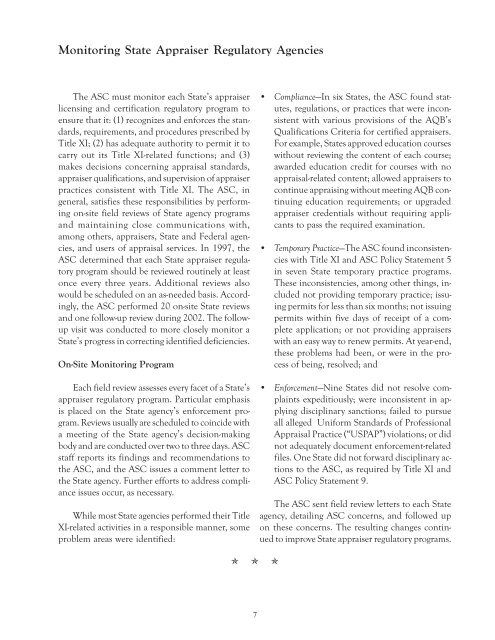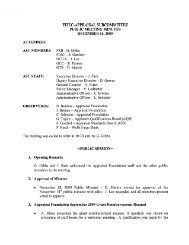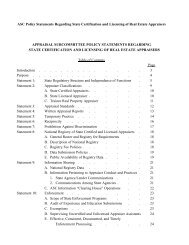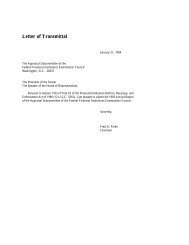Letter of Transmittal - Appraisal Subcommittee
Letter of Transmittal - Appraisal Subcommittee
Letter of Transmittal - Appraisal Subcommittee
- No tags were found...
You also want an ePaper? Increase the reach of your titles
YUMPU automatically turns print PDFs into web optimized ePapers that Google loves.
Monitoring State Appraiser Regulatory AgenciesThe ASC must monitor each State’s appraiserlicensing and certification regulatory program toensure that it: (1) recognizes and enforces the standards,requirements, and procedures prescribed byTitle XI; (2) has adequate authority to permit it tocarry out its Title XI-related functions; and (3)makes decisions concerning appraisal standards,appraiser qualifications, and supervision <strong>of</strong> appraiserpractices consistent with Title XI. The ASC, ingeneral, satisfies these responsibilities by performingon-site field reviews <strong>of</strong> State agency programsand maintaining close communications with,among others, appraisers, State and Federal agencies,and users <strong>of</strong> appraisal services. In 1997, theASC determined that each State appraiser regulatoryprogram should be reviewed routinely at leastonce every three years. Additional reviews alsowould be scheduled on an as-needed basis. Accordingly,the ASC performed 20 on-site State reviewsand one follow-up review during 2002. The followupvisit was conducted to more closely monitor aState’s progress in correcting identified deficiencies.On-Site Monitoring ProgramEach field review assesses every facet <strong>of</strong> a State’sappraiser regulatory program. Particular emphasisis placed on the State agency’s enforcement program.Reviews usually are scheduled to coincide witha meeting <strong>of</strong> the State agency’s decision-makingbody and are conducted over two to three days. ASCstaff reports its findings and recommendations tothe ASC, and the ASC issues a comment letter tothe State agency. Further efforts to address complianceissues occur, as necessary.While most State agencies performed their TitleXI-related activities in a responsible manner, someproblem areas were identified:• Compliance—In six States, the ASC found statutes,regulations, or practices that were inconsistentwith various provisions <strong>of</strong> the AQB’sQualifications Criteria for certified appraisers.For example, States approved education courseswithout reviewing the content <strong>of</strong> each course;awarded education credit for courses with noappraisal-related content; allowed appraisers tocontinue appraising without meeting AQB continuingeducation requirements; or upgradedappraiser credentials without requiring applicantsto pass the required examination.• Temporary Practice—The ASC found inconsistencieswith Title XI and ASC Policy Statement 5in seven State temporary practice programs.These inconsistencies, among other things, includednot providing temporary practice; issuingpermits for less than six months; not issuingpermits within five days <strong>of</strong> receipt <strong>of</strong> a completeapplication; or not providing appraiserswith an easy way to renew permits. At year-end,these problems had been, or were in the process<strong>of</strong> being, resolved; and• Enforcement—Nine States did not resolve complaintsexpeditiously; were inconsistent in applyingdisciplinary sanctions; failed to pursueall alleged Uniform Standards <strong>of</strong> Pr<strong>of</strong>essional<strong>Appraisal</strong> Practice (“USPAP”) violations; or didnot adequately document enforcement-relatedfiles. One State did not forward disciplinary actionsto the ASC, as required by Title XI andASC Policy Statement 9.The ASC sent field review letters to each Stateagency, detailing ASC concerns, and followed upon these concerns. The resulting changes continuedto improve State appraiser regulatory programs.✯ ✯ ✯7






